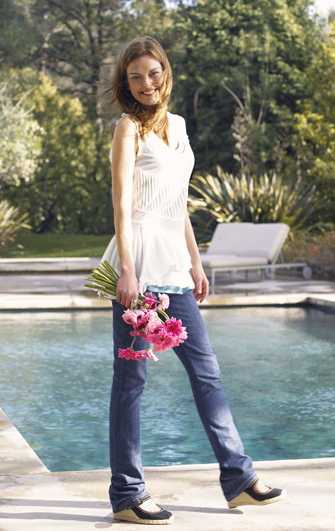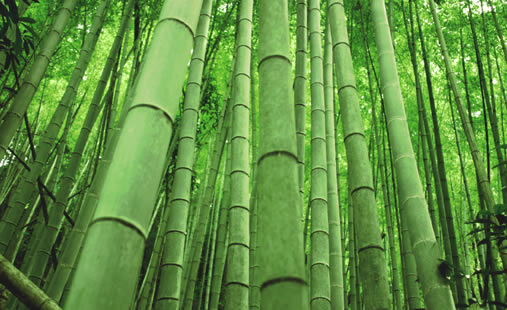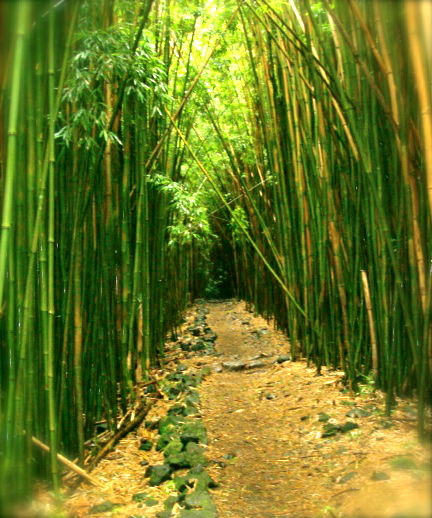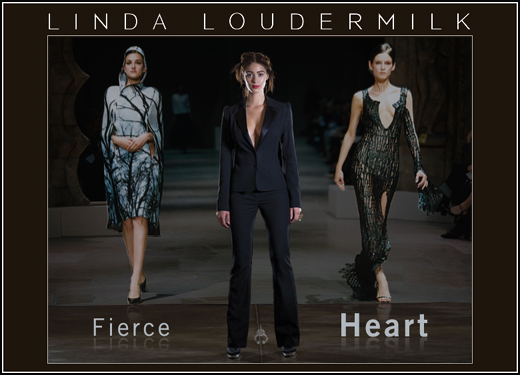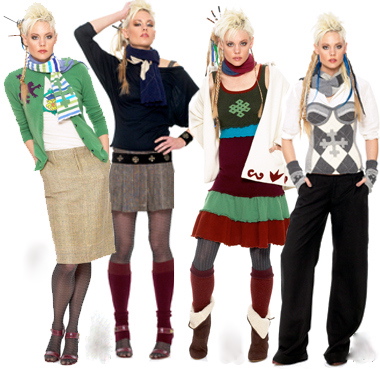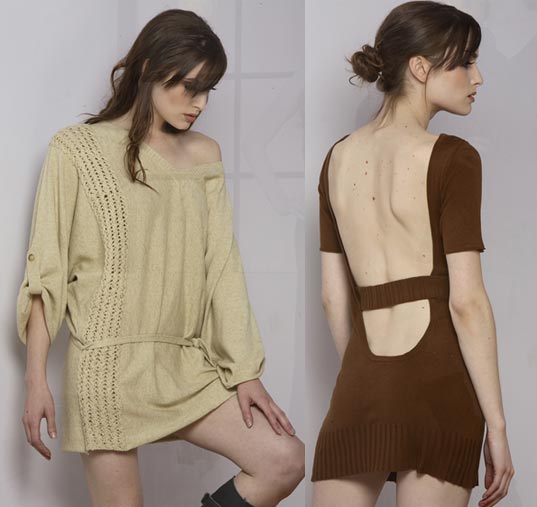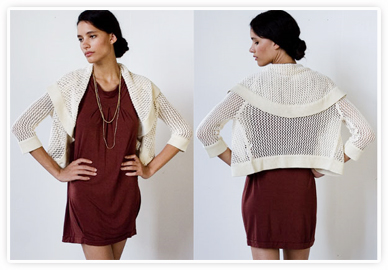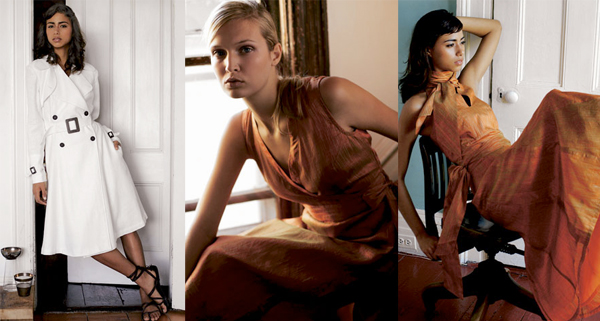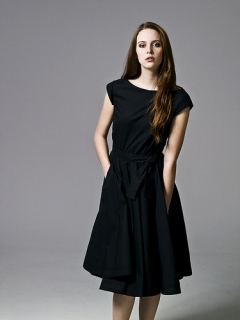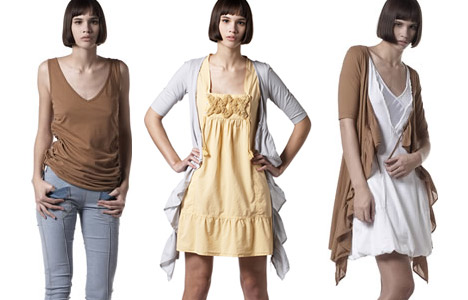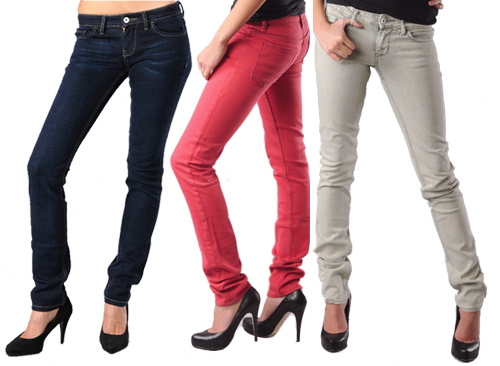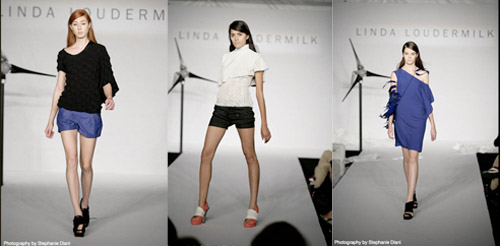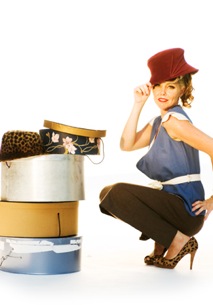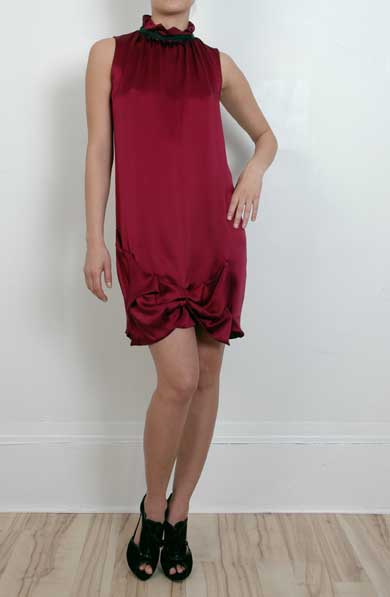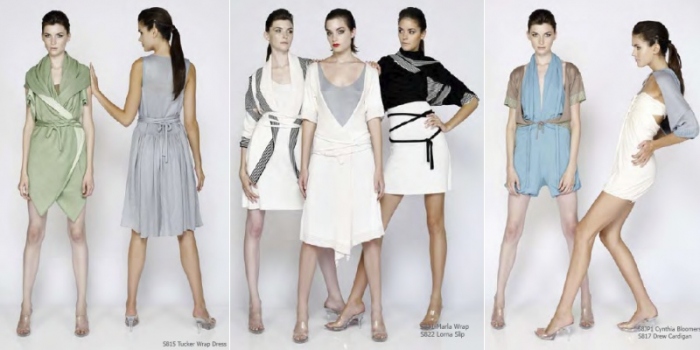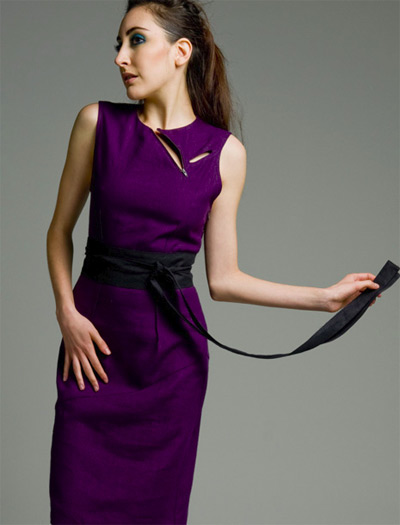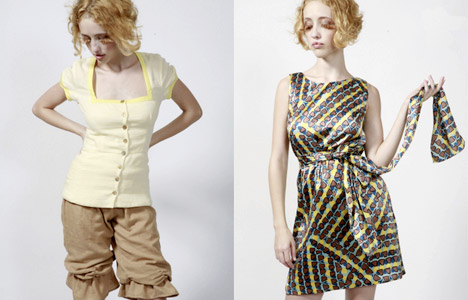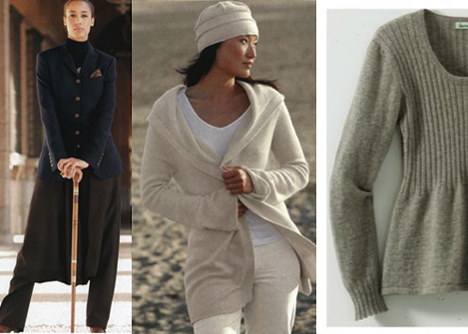Sustainable Fashion: Guide to Eco Materials
Sustainable Fashion: Guide to Eco Materials
As the spectrum of sustainable supply meets the growing crest of green demand, understanding fabric terminology will help you make the best green choices for function and fashion.
BAMBOO
WHY IT'S GREEN: Bamboo regenerates in a league of its own and grows prolifically without the use of pesticides or extensive agricultural tending. Some varieties grow several inches to several feet a day and have a root system that, after the plant is cut, sends out new shoots to replenish growth without being replanted. Bamboo cultivation gets high eco-friendly marks: it improves soil quality, shores up erosion, and sequesters carbon out of the atmosphere at an impressive rate.
FABRIC BENEFITS: Bamboo fabric is lusciously soft and supple, yet strong, and drapes beautifully. It feels softer than the softest cotton and has a natural luster similar to that of cashmere. It's highly breathable, is as absorbent as cotton, dries quickly, and is a thermal regulator, keeping you cool in hot weather and warmer in cold weather. It's easy to care for in a washing machine and dryer. Proponents say that it has natural antibacterial, hypoallergenic, and deodorizing properties due to a naturally occurring bacteriostatic agent that helps bamboo fiber resist odors and bacteria.
THE TRADE-OFF: Making stiff bamboo stalks into silky fiber can require a lot of harsh chemical solvents. There are new, more eco-friendly processing technologies, such as the Lyocell process, which dissolved pulp using less toxic and non-toxic chemicals in a close-loop system that captures and recycles the chemicals to be efficiently used again and again.
DESIGNERS THAT DO IT: Avita Style, Bahar Shapar, Bamboosa, Cosabella, Certaintees, Covet, Jonäno, Lara Miller, Linda Loudermilk, Natural High Lifestyles, Nature vs Future, Perfectly Imperfect, Roberta Oaks, Sameunderneath, Shirts of Bamboo, Spun Bamboo, Virdis Luxe
INGEO (Corn Fiber)
WHY IT'S GREEN: Made from corn, Ingeo is one of the few, truly renewable synthetic materials and is 100 percent biodegradable.
FABRIC BENEFITS: Ingeo combines the comfort and feel of a natural fiber with the specialty performance of synthetics - it's extremely strong, resilient and dimensionally stable. It's more absorbent, versatile resistant to UV light, and has a lower density than synthetics like PET polyester. Plus, it doesn't off-gas or cause environmental contamination to dispose of, and can be beautifully blended with natural fibers such as cotton and wool.
THE TRADE-OFF: Since ingeo is made from corn, it very well may contain genetically modified organisms (GMO) as a vast majority of corn does.
DESIGNERS THAT DO IT: Linda Loudermilk, Nature vs Future
HEMP
WHY IT'S GREEN: Hemp grows like a weed. It's sustainable, highly renewable and grows more easily than cotton in less than ideal conditions without the use of pesticides and can produce 2 to 3 times more fiber per acre than cotton.
FABRIC BENEFITS: Hemp is absorbent, extremely durable and versatile - it blends beautifully with other natural fibers and can be as soft as soft cotton, as sturdy as denim, and as flowing as denim. Thanks to the hollow core of the fiber, hemp is a thermal regulator, keeping you cooler in warm weather and warmer in cool weather.
THE TRADE-OFF: The stigma of hemp, due to it's drug-related cousin marijuana and the early burlap-sack eco-designs have made it an oft-overlooked fiber for fine clothing, though that's changing. Like linen, hemp needs to be ironed for a smooth appearance, and does get wrinkly.
DESIGNERS THAT DO IT: Deborah Lindquist, Jonäno, Lara Miller, Linda Loudermilk, Natural High Lifestyles, Nature vs Future, Of the Earth, Small Axe Clothing, Stewart + Brown, Virdis Luxe
MODAL
WHY IT'S GREEN: This bio-based synthetic is made from reconstituted beech trees with a renewable process and is 100% biodegradable.
FABRIC BENEFITS: Modal blends the best qualities of a natural and synthetic fiber - it's luxuriously soft, 50% more absorbent than cotton, but dyes just as well, doesn't pill or shrink, and holds color fast and is resistant to fading. It dried very quickly and can be blended with cotton for a silky smooth finish and sound structure that holds even after repeated washing and wearing. It even resists mineral deposits from hard water, such as lime from sticking to the surface.
THE TRADE-OFF: Like pure cotton, modal needs to be ironed after washing for a smooth appearance.
DESIGNERS THAT DO IT: Cosabella, Calvin Klein, Swati Argade
ORGANIC COTTON
WHY IT'S GREEN: Certified organic cotton is grown without chemical pesticides, insecticides or fertilizers. It supports a halthy ecosystem, improves soil quality, often uses less water than conventional cotton and won't contaminate water with toxic chemicals.
FABRIC BENEFITS: Organic cotton is often very high quality. Cotton is extremely versatile, breathable, absorbent, durable, and delectably soft. It can be blended with almost any other fiber, natural or synthetic, is easy to care for and takes dye beautifully.
THE TRADE-OFF: Organic cotton can have a longer growth cycle, require more skill to grow and cost more to produce than conventional cotton, and is therefore often more expensive. Some companies use organic cotton only in part or uncertified cotton and still make the claim to green fame. Not all organic cotton is dyed or bleached naturally, so look for companies with transparent practices whenever possible.
DESIGNERS THAT DO IT: American Apparel, Aaron Chang, Anna Cohen, Bahar Shahpar, Blue Canoe, Burning Torch, Certaintees, Covet, Del Forte, Dockers, Doie, Edun, Ekyog, Emily Katz, FIN, Grace & Cello, Green Dragon, Hess-Natur, H&M, John Patrick Organic, Jonäno, Kelly B Couture, Lara Miller, Levi's, Linda Loudermilk, Loomstate, Loyale, Mavi Jeans, Natural High Lifestyles, Nature vs Future, Nau, Noir, Of the Earth, Patagonia, Perfectly Imperfect, Prairie Underground, Rebe, Restore Clothing, Roberta Oaks, Sameunderneath, Shirts of Bamboo, Small Axe Clothing, Stewart + Brown, Swati Argade, Threads for Thought, Topo Ranch, Urban Outfitters, Virdis Luxe, White+Warren
SASAWASHI
WHY IT'S GREEN: Made from a blend of Japanese paper and the kumazasa herb, it's completely natural, highly renewable without the use of chemicals, and does not require chemicals to process.
FABRIC BENEFITS: Sasawashi weaves beautifully into fabric that is has a soft feel like cashmere or Egyptian cotton, yet has a dry-touch like linen. It does not pill or fuzz, is twice as absorbent as cotton and is said to have natural antibacterial and deodorant properties. It's produced by twisting the paper-fiber into a yarn that does not knot; therefore sasawashi is highly durable. It blends well with other natural fibers, is highly absorbent and blocks UV rays notably well.
THE TRADE-OFF: This rare fabric is not being commonly used by American designers...yet. It's fairly pricy to produce and hails from Japan, so shipping requires a lot of fuel.
DESIGNERS THAT DO IT: Linda Loudermilk
SEACELL
WHY IT'S GREEN: This luxurious natural fiber is woven from nutrient-rich seaweed combined with eco-friendly Lyocell.
FABRIC BENEFITS: This elegantly draping, super-soft, breathable fiber actually nourishes the skin with nutrients such as calcium, magnesium and vitamin E, which is released by natural body moisture when worn. It has anti-inflammatory properties, improves circulation and helps the skin to regenerate. All of these medicinal properties remain in tact even after regulare washing and wearing.
THE TRADE-OFF: Very few designers are using this exotic fiber because it's rare to source and expensive to produce, and therefore reflected in the price of garments that flaunt it.
DESIGNERS THAT DO IT: Linda Loudermilk, Nature vs Future
SOY FIBER
WHY IT'S GREEN: Soy fiber is a byproduct of making tofu. Though not edible, certainly renewable.
FABRIC BENEFITS: Affectionately called "veggie cashmere," soy fiber is extremely soft, absorbent, breathable, and can be woven into lightweight, cashmere-like material that has luster like silk with a touch of stretch that drapes beautifully. Blends very well with other natural fibers for a silky feel and versatile function, holds color fast and resists color fading. It resists shrinkage and wrinkling, is easy to care for and dries quickly.
THE TRADE-OFF: Soy that is not organic is likely to contain genetically modified organisms (GMO) and contribute to pesticide pollution. It can require more energy to produce than be more expensive and is only moderately available.
DESIGNERS THAT DO IT: Covet, Lara Miller, Linda Loudermilk, Nature vs Future, Of the Earth, Small Axe Clothing
LYOCELL + TENCEL®
WHY IT'S GREEN: Tencel is a brand name for a type of Lyocell, which is a synthetic fabric extracted from wood pulp harvested from sustainable managed forests. As a fiber, it's classified as a sub-category of rayon, but it's manufactured with more eco-friendly processes, using a closed-loop recycling process that doesn't involve chlorine.
FABRIC BENEFITS: Tencel and Lyocell are soft, absorbent, and resist wrinkling; these fibers have a lustrous, silky appearance and feel, but are very strong, even when wet. Blends beautifully with other natural fibers such as silk, cotton, and wool as well as synthetic fibers such as polyester and nylon.
THE TRADE-OFF: Both are more expensive to produce than conventional cotton or rayon, so garments that contain these fibers often reflect that.
DESIGNERS THAT DO IT: Lara Miller, Natural High Lifestyles, Nature vs Future, Patagonia, Small Axe Clothing
RECYCLED + REPURPOSED + VINTAGE MATERIALS
Recycled Materials Used: Cashmere, Cotton, Leather, Mill End Surplus, Nylon, Polyester, Silk, Wool
WHY IT'S GREEN: Recycling anything that already exists is green and more sustainable that making anything new. It saves energy and reduces pollution and waste, even when compared to producing new, natural organic fibers. It seems that almost anything can be recycled into something useable, and clothing designers are getting fantastically creative with recycling materials, whether its eco-polyester made from recycled soda pop bottles and discarded garments or deconstructing vintage pieces to fashion new ones. Dream a sustainable dream: a rain jacket or swimsuit made from recycled polyester, a cashmere sweater perfectly pieced together from hand-selected pieces, a chic trench coat made from recycled wool, a smart button down from reclaimed cotton, a sophisticated blouse made from a combination of vintage scarves, a handbag mage from discarded candy wrappers, pop tabs, or vintage auto upholstery. All exist in gorgeous form at the apex of sustainable style.
FABRIC BENEFITS: Recycled fabrics opens up the playing field enabling designers to use versatile materials that may not be natural though are thoroughly eco.
DESIGNERS THAT DO IT: Aaron Chang, Anna Cohen, Bahar Shahpar, Burning Torch, Deborah Linquist, Doie, Emily Katz, Eciost, FIN, Grace & Cello, Hess-Natur, John Patrick Organic, Kim White Handbags, Linda Loudermilk, Loomstate, Nahui Ollin, Nature vs Future, Nau, Patagonia, Rebe, Restore Clothing, Swati Argade, Urban Outfitters

